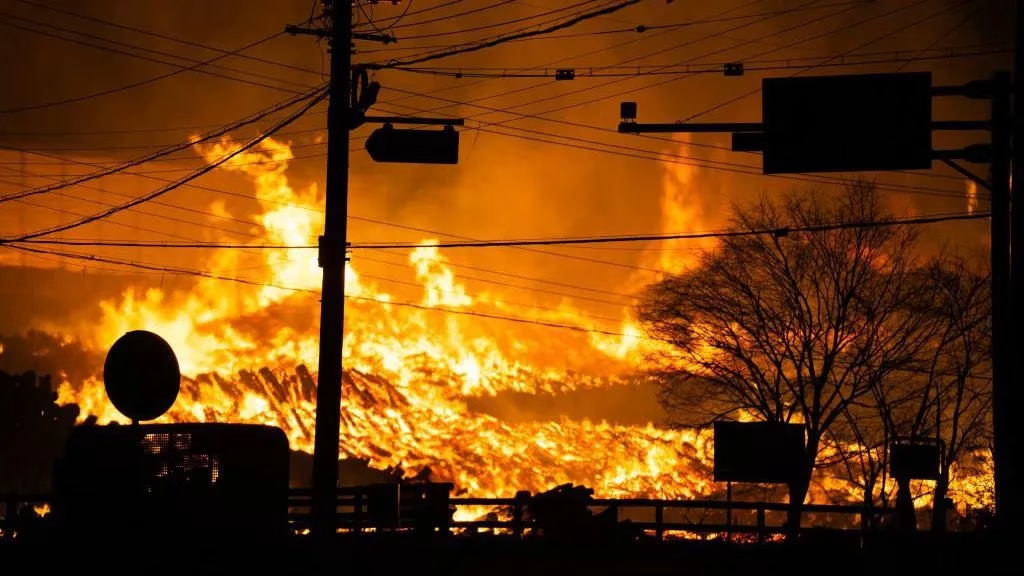At least 24 people have died as multiple wildfires continue to devastate the southeastern region of South Korea. Most of the victims are in their 60s and 70s, according to authorities, who also report that around 26 individuals have been injured, with 12 in critical condition. The wildfires have forced more than 23,000 people to evacuate their homes.
Acting president Han Duck-soo described the situation as “unprecedented,” stating that it is “rewriting the record books” for the worst wildfires in the nation’s history. Among the destruction, the 1,300-year-old Gounsa temple in Uiseong city was gutted by the flames, though many cultural relics were successfully removed and moved to safety.
The fires began in Sancheong county on Friday afternoon and later spread to Uiseong county. Fueled by strong, dry winds, the fires have since reached neighboring counties including Andong, Cheongsong, Yeongyang, and Yeongdeok, according to Yonhap news agency. The Uiseong fire is spreading at an “unimaginable” pace, according to Lee Byung-doo, a forest disaster expert from the National Institute of Forest Science.
A firefighting helicopter crashed in the mountains of Uiseong county on Wednesday afternoon, with authorities currently investigating the cause. In response to the wildfires, thousands of firefighters and approximately 5,000 military personnel have been mobilized to fight the flames, along with helicopters from the US military stationed in Korea.
On Tuesday, the national fire agency raised the crisis to the highest fire response level, marking the first time such an alert has been issued this year. Wildfires are rare in South Korea, and fatalities from them are even rarer. However, these fires, which have already claimed 18 lives in the past few days, are now the deadliest wildfires in the nation’s history. More than 17,000 hectares (42,000 acres) of forest have been destroyed, making this the third-largest wildfire in the country in terms of land area.
In Uiseong, the flames consumed the Gounsa temple, which was built in 618 AD and once stood as one of the largest temples in the province. A Buddhist architectural structure from the Joseon Dynasty (1392-1910) was also destroyed. Forestry authorities confirmed the loss. A 68-year-old monk expressed his devastation over the destruction, stating, “We will do our best to restore the function of the temple,” adding that it was a painful and incomprehensible experience.
In Andong, truck driver Lee Seung-joo described witnessing the mountains burning like “literal hell” as he passed by. “It was like the apocalypse,” said the 39-year-old. Elsewhere in Andong, evacuees taking shelter at an elementary school were urgently told to evacuate as the fire rapidly spread due to gusty winds. “The wind was so strong,” said 79-year-old evacuee Kwon So-han. “The fire came from the mountain and fell on my house.”
Acting president Han stated that all available resources and personnel have been deployed to fight the fires, though strong winds continue to hamper efforts. “We were desperately hoping for rain today or tomorrow to help extinguish the flames,” Han said. However, the Korea Meteorological Administration reported no rain expected on Wednesday and only a small amount – 5 to 10mm – forecast for Thursday.
Han emphasized that once the crisis is under control, the government will thoroughly review any shortcomings in the wildfire response and strengthen future prevention strategies. “Once a wildfire starts, extinguishing it requires tremendous resources and puts precious lives in danger,” he added.
South Korea has been experiencing drier-than-normal conditions, with rainfall well below average. This year, 244 wildfires have already been reported, more than double the number from the same period last year. The government also vowed to step up enforcement against illegal burning, one of the primary causes of wildfires, and to crack down on individual negligence.

